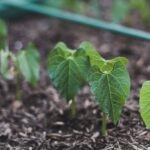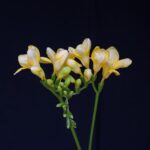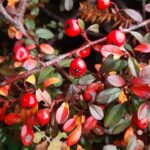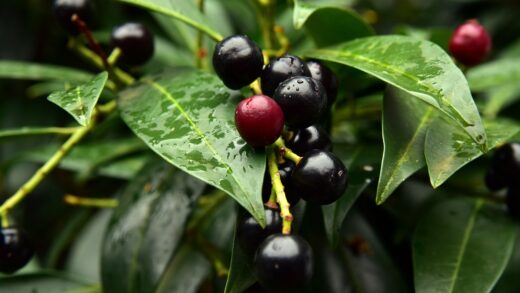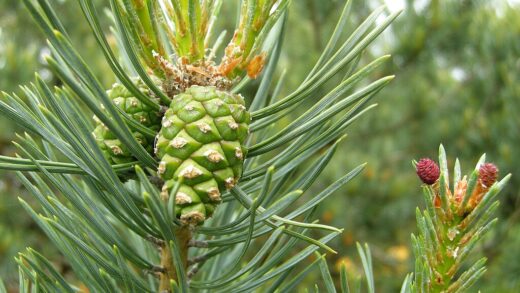The grey-leaved cotoneaster, scientifically known as Cotoneaster glaucophyllus, is an exceptionally rewarding and versatile ornamental shrub that, with proper care, can be a jewel in our garden for years. Originally from the mountainous regions of China, it has now become a popular plant worldwide, thanks to its low maintenance requirements and high ornamental value. Its dense, arching branch system and greyish-green, small leaves lend it an elegant appearance that is attractive all year round. However, the plant’s true appeal lies in its late spring to early summer white blooms and the subsequent vibrant red berries that are decorative in autumn and winter, serving not only as a beautiful sight but also as an important food source for birds.
The grey-leaved cotoneaster is among the easiest shrubs to manage, making it ideal even for beginner gardeners. It adapts particularly well to various environmental conditions, including urban, more polluted air, so it can be confidently planted in street-front gardens and parks. Due to its low stature and spreading habit, it is excellent as a ground cover, for stabilising slopes, but it also holds its own as a solitary plant or in a low hedge. It is important to note that while the plant’s berries are edible for birds, they are mildly toxic to humans, so this should be considered when placing it in gardens with small children.
The shrub’s popularity is further enhanced by its evergreen or semi-evergreen character, meaning it retains its leaves during milder winters, so the garden does not become completely bare in the colder months. The greyish leaves add a fine texture to the garden’s composition, creating a contrast with other, darker-leafed plants. The most important aspects of its care are choosing the right location and ensuring more regular watering in the initial years; afterwards, the plant becomes almost self-sustaining. We will now detail all the important steps for successful cultivation.
The grey-leaved cotoneaster is thus a truly multifunctional plant that richly rewards the gardener with minimal care. Its decorative appearance, ecological role, and low maintenance needs combine to make it an essential element in both modern and traditional gardens. In the following sections, we will show how to provide it with the optimal conditions to get the most out of this wonderful shrub, ensuring its healthy development and abundant yield.
Ideal planting location and soil requirements
The most ideal location for the grey-leaved cotoneaster is in a sunny or partially shaded position. Although it tolerates shadier conditions, it achieves its most beautiful form, densest foliage, and most abundant flowering and fruiting in full sun. Sunlight also intensifies the greyish hue of the leaves, further enhancing the plant’s ornamental value. Deeply shaded places should be avoided, as the shrub may become leggy, its foliage sparse, and it will be more susceptible to diseases. When choosing a planting site, consider the plant’s final size, which can reach a height and width of 2-3 meters.
More articles on this topic
In terms of soil, the grey-leaved cotoneaster is extremely tolerant, thriving in almost any type of soil as long as it has good drainage. It prefers neutral or slightly acidic to slightly alkaline soils that are moderately rich in nutrients. It does not tolerate waterlogged, heavy clay soils, as its roots can easily start to rot. Therefore, before planting, it is advisable to loosen the soil and, if necessary, improve its structure with sand or compost for better drainage. This step is particularly important during the initial establishment phase.
Preparing the planting hole is crucial for the successful establishment of the plant. It is recommended to dig a hole at least twice, but preferably three times, the size of the root ball in both depth and width. It is a good idea to spread a layer of mature compost or organic manure at the bottom of the hole, which provides initial nutrients and stimulates root development. The excavated soil can also be mixed with compost before backfilling. Carefully remove the plant from its container and place it in the hole so that the root collar is level with the soil surface, then backfill the soil and water thoroughly.
The grey-leaved cotoneaster is also excellently suited for planting on slopes and at the top of retaining walls, where its spreading habit effectively binds the soil and prevents erosion. In such locations, it is particularly important that the soil is well-drained, as water flows away more easily on a slope, but waterlogging from overwatering can be just as harmful. It can also be grown as a container plant in an urban environment, but in this case, be sure to choose a container of an appropriate size and water it regularly, as the soil of container plants dries out more quickly.
Watering and nutrient supply
Newly planted grey-leaved cotoneaster requires regular watering for the first one to two years, until its root system penetrates deep and strengthens. During this initial period, thorough watering on a weekly basis is particularly important during dry, drought-like periods to moisten the entire root zone. Instead of shallow, frequent watering, prefer less frequent but more abundant water applications, which encourages deeper root growth. It is best to water early in the morning or late in the evening to minimise evaporation loss.
More articles on this topic
Once well-established, specimens that have been in place for several years become extremely drought-tolerant. At this point, they only need supplementary watering during prolonged, extreme droughts. The plant adapts excellently to drier conditions, thanks to its deep-penetrating root system and the waxy coating on its leaves, which reduces transpiration. Overwatering poses a much greater threat to it than periodic drought, as root rot can be fatal. Always allow the top layer of the soil to dry out between waterings.
The grey-leaved cotoneaster is not a particularly nutrient-demanding plant, but it appreciates a spring nutrient boost. In early spring, at the beginning of the growing season, it is advisable to apply a layer of mature compost or a slow-release, complex fertiliser around its base. This provides enough energy for the plant to grow new shoots, flower profusely, and produce fruit. Avoid excessive nitrogen-heavy fertilisation, as it stimulates excessive foliage growth at the expense of flowers and fruits, and makes the plant more susceptible to diseases.
In autumn, covering the base with organic matter, such as compost or leaf mould, not only protects the root system from winter frosts but also serves as a slow-release nutrient source for the following spring. This method is especially recommended for young plants. Container-grown specimens require more frequent nutrient supply, as nutrients are depleted more quickly from the limited amount of soil. For them, a liquid, balanced fertiliser can be used during the growing season, every two weeks or monthly, according to the product’s instructions.
Correct timing and techniques for pruning
The grey-leaved cotoneaster generally does not require regular, heavy pruning, as its natural form with its arching branch system is extremely decorative on its own. The primary purpose of pruning is to remove dead, diseased, or damaged branches, as well as to control the plant’s size and shape it. The most ideal time for pruning is late winter or early spring, before the buds break. During this period, the plant is still dormant, so pruning is less stressful, and the wounds heal faster.
During formative pruning, the aim should be to preserve the shrub’s natural, loose habit. If the plant becomes too dense, its inner parts will not receive enough light and air, which can lead to leaf die-off and the appearance of fungal diseases. In such cases, it is advisable to perform thinning pruning, which means removing a few older, thicker branches from the base. This stimulates the growth of new, fresh shoots and ensures proper ventilation of the foliage. Avoid drastic cutting back, as it can lead to the loss of the natural shape.
If the grey-leaved cotoneaster is grown as a hedge, more frequent trimming is needed to maintain the desired shape. The first trimming should be done after flowering, in early summer, and can be repeated as needed throughout the summer. It is important not to trim too late in the autumn, as the newly growing shoots will not have time to mature before winter sets in and can easily be damaged by frost. When trimming a hedge, ensure that the base of the hedge is slightly wider than the top, so that the lower branches also receive enough sunlight.
Always use sharp, clean pruning shears or loppers for pruning. Dull tools crush the plant tissues, which hinders wound healing and opens the way for pathogens. It is advisable to treat larger cut surfaces with a wound sealant to prevent infections. After pruning, the plant needs more energy for regeneration, so a light nutrient supplement and adequate water supply can help it recover more quickly.
Plant protection: the most common diseases and pests
The grey-leaved cotoneaster is a fundamentally resilient plant that is attacked by relatively few diseases and pests, especially when grown under optimal conditions. The most common problem is fire blight, a bacterial disease that affects plants in the rose family. The signs of infection are suddenly wilting, then blackening shoot tips, flowers, and leaves that look as if they have been scorched. The key to prevention is a suitable, airy planting location and avoiding excessive nitrogen fertilisation. In case of infection, the diseased parts must be immediately removed with at least 20-30 cm of healthy section and destroyed.
Powdery mildew is another fungal disease that can appear mainly in humid, warm weather or in overcrowded, poorly ventilated stands. A white, powdery coating forms on the leaves and shoots, which inhibits photosynthesis and weakens the plant. To prevent this, ensure good air circulation around the plant and avoid watering the foliage in the evening. In mild cases, removing the infected leaves may be sufficient; in more severe cases, the use of sulphur-based or other systemic fungicides may be necessary.
Among pests, aphids and scale insects can occasionally cause problems. Aphids usually suck on the young shoot tips and the undersides of the leaves, distorting the leaves and excreting honeydew, which attracts ants and promotes the growth of sooty mould. Scale insects form a small, shield-like coating on the stems and branches and also feed on the plant’s sap. For both pests, their natural enemies, such as ladybirds, can be deployed, or in milder cases, washing with soapy water can also be effective. In more severe infestations, the use of insecticides is justified.
Prevention is always the most effective control strategy. A healthy, well-conditioned, properly cared-for plant is much more resistant to diseases and pests. Regularly inspect your plants to detect the first signs of problems in time. Choosing the right growing site, providing balanced nutrient supply, expert pruning, and correct watering practices all contribute to keeping your grey-leaved cotoneaster healthy and decorative for many years.
Propagation of the grey-leaved cotoneaster
The grey-leaved cotoneaster can be propagated in several ways, allowing you to easily obtain new plants from your existing stock. The most commonly used and simplest method is by semi-hardwood cuttings. This should be done in mid-summer, from July to August. Select healthy shoots from the current year, the lower part of which has already become slightly woody, but the tip is still green and flexible. Cut 10-15 cm long pieces from the shoots, making the cut just below a leaf node.
Remove the lower leaves from the cut cuttings, leaving only the top 2-3 leaves to reduce transpiration. It is advisable to dip the base of the cuttings in rooting hormone, which significantly increases the chance and speed of rooting. Then, stick the cuttings into pots or propagation trays filled with a loose, sandy, peaty medium. Keep the medium constantly moist, but not waterlogged. To ensure high humidity, cover the pot with a transparent plastic bag or a pane of glass, but ventilate it daily to prevent fungal growth.
Rooting usually takes 4-8 weeks. When the cuttings start to produce new shoots, it is a sure sign of successful root formation. At this point, the cover can be gradually removed to accustom the young plants to drier air. Carefully transplant the rooted cuttings into individual pots and continue to grow them in a protected place. It is advisable to wait until the following spring to plant them out in the open ground, when they have strengthened and are more resistant to outdoor conditions.
Another, though less common, method is propagation by seed. Collect the berries in autumn when they are fully ripe. The seeds must be separated from the fruit pulp and then subjected to cold treatment, so-called stratification, which mimics the effect of winter frost and breaks dormancy. To do this, mix the cleaned seeds with moist sand or peat, place them in a bag, and put them in the refrigerator for 2-3 months. In spring, sow the seeds in loose, nutrient-rich seedling soil. Plants grown from seed develop more slowly and may differ in their characteristics from the parent plant.
Winter preparation and frost protection
The grey-leaved cotoneaster is an extremely frost-hardy shrub that generally survives winters in Hungary without damage. Well-established specimens that have been planted for several years do not require any special winter protection. Their resilience is further increased if they are planted in a sunny, wind-protected location. Nevertheless, young, freshly planted shrubs can be more sensitive to hard frosts in their first one or two winters, so it is worth providing some protection for them.
The most important task for young plants is to cover their base. In late autumn, before the first serious frosts, pile a 10-15 cm thick layer of mulch around the base of the plant. Leaves, pine bark, straw, or mature compost are excellent for this purpose. This covering layer insulates the soil, protects the root system from freezing through, and helps to retain soil moisture. In spring, after the danger of frost has passed, the mulch should be carefully removed from around the base or worked into the soil.
Container-grown grey-leaved cotoneasters are at increased risk of frost damage, as their root system is protected from the cold by only a thin pot wall. These plants should be moved to a sheltered location before winter sets in, for example, next to a wall, in a frost-free but cool garage or cellar. If this is not possible, wrap the pot in burlap, bubble wrap, or other insulating material and place it on a polystyrene sheet to protect it from frost from below. During the winter, also ensure that their soil does not dry out completely; water them moderately on frost-free days.
Winter precipitation, especially snow, provides natural protection for plants. The snow cover is an excellent insulator that protects the base and lower branches from the harsh cold. However, if a large amount of heavy, wet snow falls, it can break the shrub’s branches. In such cases, it is advisable to gently shake the snow mass off the branches to prevent damage. The combined effect of winter sun and frosty wind can also cause damage, primarily the drying out of the leaves, but the plant usually regenerates well from these injuries in the spring.
The grey-leaved cotoneaster in garden design
Thanks to its versatility, the grey-leaved cotoneaster is excellently suited for numerous garden design tasks. Its low, spreading, or arching habit makes it an ideal ground cover plant. Planted in groups on larger surfaces, slopes, or at the top of retaining walls, it forms a dense, closed cover that effectively suppresses weeds and binds the soil. Its greyish-green foliage creates a beautiful contrast with the green of the lawn or with other, darker-leafed shrubs, such as barberries or thujas.
It can also be planted as a low, unclipped or clipped hedge to border gardens, garden paths, or flower beds. Its dense branch system provides good screening, and the white flowers in spring and the red berries in autumn and winter offer a varied sight throughout the year. As an unclipped hedge, it retains its natural, loose form, while regular clipping can create precise, geometric shapes. It also combines well with other flowering or evergreen hedge plants with similar requirements.
As a solitary plant, or specimen, the unique shape and ornamental value of the grey-leaved cotoneaster are also well highlighted. Placed in the middle of a lawn, next to an entrance, or near a garden seating area, it attracts the eye. In such cases, it is advisable to let the plant reach its natural size and shape and perform only the most necessary corrective pruning. Its arching branches exude elegance, and the berries bring colour and life to the winter garden, attracting birds.
From an ecological point of view, it can also be a valuable member of the garden. Its nectar-rich flowers attract pollinating insects, such as bees and bumblebees, in spring, contributing to the garden’s biodiversity. The red berries, which ripen in autumn and remain on the bush for a long time, are an important food source for birds during the scarce winter months. When designing a bird-friendly garden, the grey-leaved cotoneaster is an almost indispensable element that provides both shelter and food for our feathered friends.







